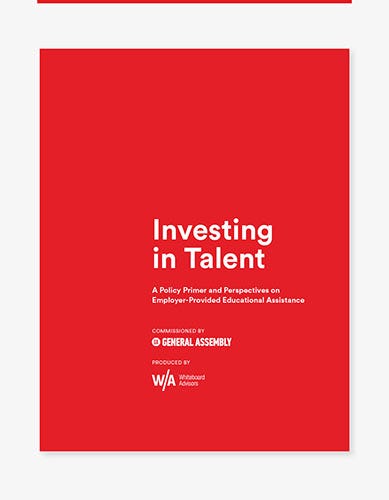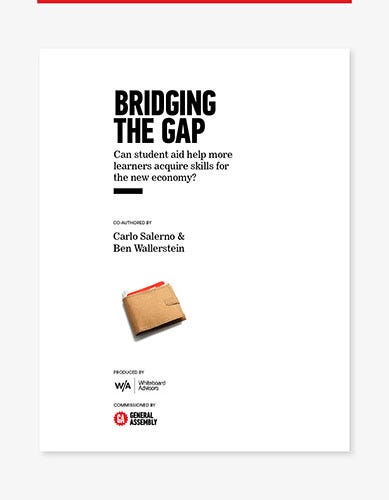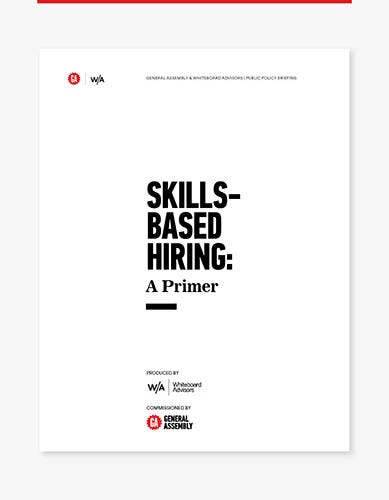Create opportunities for employers and job-seekers alike with these proposed policies to help close chronic skills gaps.
A tightening labor market, persistent skills gaps (in fields from manufacturing to technology), and the short shelf life of skills in the rapidly changing digital economy, have led to a seemingly paradoxical narrative in the education-to-employment pipeline.
In manufacturing, for instance, 70 percent of companies now face shortages of workers with the necessary technology skills. And yet millions of Americans struggle to find jobs that put them on a path toward social and economic mobility or, at least, a comfortable perch in the middle class.
What’s worse, the compounding forces of automation and artificial intelligence (AI) will begin to dislocate a growing number of workers — putting unprecedented pressure on an education and workforce development system that is ill-equipped to tackle looming reskilling and training challenges.
New Models Emerge
In the last five years, an array of non-accredited education and training providers has surfaced to address these challenges, including General Assembly, as well as on-demand learning platforms, ultra-low-cost course providers (like StraighterLine or Coursera), and new approaches to “education as an employee benefit” (pioneered by companies like Chipotle, in partnership with Guild Education).
These new providers are, in many cases, closely linked to employers — reskilling workers to meet new demands of the labor market (such as data science, cybersecurity); and reducing costly turnover. They are experimenting with new funding models (like income-share agreements), modern-day apprenticeships (like the Adobe Digital Academy), and creating opportunities for individuals to earn college credit for on-the-job training.
But new models rarely fit neatly within existing federal policies designed to stimulate investments in our national talent pipeline at a time when the provider landscape was far less diverse.
In the coming years, our system of education and workforce development will continue a slow but fundamental paradigm shift: moving away from historic proxies like degrees and credentials and toward a faster and more fluid system centered on skill development that facilitates economic mobility. Employers will play a growing role as both payers and evaluators of quality and outcomes.
But in the interim, policy changes within existing programs and regulations can create near-term opportunities for both employers and job-seekers to gain valuable skills and close persistent skills gaps across the economy.
Here are the top nine policy ideas we’d like to see in place, and actions that are being taken to implement them:
1. Align yesterday’s tuition reimbursement caps with today’s training costs.

In GA’s white paper Investing in Talent (PDF), we took a look at the sections of Internal Revenue Code that facilitate tax-advantaged opportunities for businesses to invest in the education of their employees — with perspectives from those working to support the educational aspirations of workers and to attract and retain talent. Section 127 of the Internal Revenue Code allows employers to provide employees with up to $5,250 in tax-free reimbursement for higher education. But the current cap of $5,250 has not changed since 1986.
- Indexed to inflation, this benefit would be worth over $11,500 today. Raising the cap would enable employers to fund a larger portion of their employees’ education expenses while retaining the tax benefits. This section could also be expanded to cover other education expenditures. Legislation introduced in Congress would, for example, allow employers to cover loan payments, as well as tuition, under Section 127.
2. Implement income-share agreement (ISA) policies.
Colleges and universities like Purdue, along with nontraditional providers like GA, are exploring an unconventional approach to financing education that de-risks the investment for students — and align interests between institutions and outcomes.
An income-share agreement (ISA) is a contract in which a person agrees to pay a fixed percentage of their income for a defined length of time in exchange for up-front funding or services. In higher education, this contract is typically between a student and an institution. ISAs differs from loans in a number of ways, including how repayment amounts are calculated: With a loan, the individual makes payments based on an interest rate until their principal balance is reduced to zero. With an ISA, the individual pays a percent of income for a set period of time, regardless of the total amount paid. There is no outstanding “balance.”
- Despite their potential, ISAs currently lack the federal oversight and consumer protections provided by federal loans. Legislation proposed by Sen. Marco Rubio (R-Fla.) and cosponsored by Sens. Daniel Coates (R-Ind.) and Tom Cotton (R-Ark.) takes a first step toward setting standards for both disclosure to consumers, as well as protection for ISA providers from certain consumer-protection lawsuits.
3. Rethink employer incentives.
AI, machine learning, and automation are fueling rapid shifts in employer demands — and placing unprecedented demands on employees to develop new skills to keep a job. At a time when our systems of higher education and workforce development are ill-equipped to meet both worker and employer demand, employers will play an increasingly important role in skill training.
- The Aspen Institute has proposed a “Worker Training Tax Credit,” which provides a policy framework for powerful new incentives to stimulate corporate investments in talent development and retention. The credit, whose value would be 20% of the difference between an employer’s current year qualified training expenditure and an established base expenditure level, would cover employer-provided training leading to an industry-recognized credential.
- And recent legislation introduced by Sens. Susan Collins (R-Maine) and Maria Cantwell (D-Wash.) would further incentivize employers to pursue apprenticeships through the creation of a $5,000 tax credit for companies that hire workers enrolled in apprenticeship programs.
4. Expand individual education tax deductions.

In our report Bridging the Gap (PDF), General Assembly explored policy alternatives for students pursuing accelerated learning programs, including the expansion of individual tax deductions for education. While a few of these tax provisions (like the federal Lifetime Learning Credit) are open to non-accredited institutions, the majority require that an institution participate in the Federal Student Aid program.
With an average tuition of $15,000 for a 12-week program, short-term accelerated learning programs in coding and other fields provide a viable pathway toward employment for an increasingly diverse cross section of job seekers. At a time when accredited institutions produce just under 50,000 computer science graduates annually, nearly 20,000 graduates from accelerated learning programs are playing a critical role in closing skills gaps for major employers.
- Education tax deductions should be extended to individuals who invest in educational experiences that are high quality and demonstrate compelling evidence of workforce relevance, regardless of whether they are accredited.
5. Allow penalty-free education investments from tax-advantaged accounts.
Bridging the Gap (PDF) also considers whether one-time, penalty withdrawals from retirement or education savings accounts such as 529 or 401(k) plans should be permissible for students enrolled in non-accredited training programs.
- At a time when both skills gaps and the risk of technological unemployment looms large, one-time withdrawals from retirement accounts could facilitate access to accelerated learning programs for workers seeking new skills in an increasingly dynamic job market — given the relatively low cost and short duration of such programs.
6. Expand in-school deferment.
With nearly half of college graduates now working in jobs that don’t require a degree, skills-based training plays a critical role in addressing chronic underemployment — and creating a pathway to higher wages.
Students enrolled in professional or graduate programs at colleges and universities typically have the opportunity to apply for in-school deferment of loans, postponing repayment until graduation. Sadly, loan deferment often contributes to spiraling debt loads as graduates pursue JDs or MBAs to make good on prior educational investments — only to emerge with more debt, and grim job prospects.
- Currently, deferment is limited to institutions participating in the Federal Student Aid programs. Expanding loan deferment to cover students enrolled in non-accredited programs would enable students to avail themselves of shorter, lower-cost alternatives to graduate school — upskilling undergraduate credentials, without taking on the debt often associated with postgraduate degrees.
7. Reciprocity where it makes sense.

Although accredited institutions are often exempt from state licensure, non-accredited providers must comply with a patchwork of state-based rules and requirements. These policies and regulations play a critical role in protecting consumers and weeding out unscrupulous providers. But most focus on inputs (e.g., financial solvency) and transparency (e.g., refund policies) rather than outcomes. Beyond licensure, states also have separate policies to approve access to federal programs, such as the GI Bill, which slows adoption and limits access to new models and approaches, particularly in high demand technology fields.
- In our report Beyond Bootcamps (PDF), General Assembly considered the benefits and risks of creating greater consistency among state policies and regulations. Creating frameworks for reciprocity among neighboring states may make sense when providers can demonstrate target quality levels or outcomes. The federal government could also lead in key areas, like the GI Bill, where the Veterans Administration might pursue alternatives to the current state-by-state patchwork of approvals by state approving agencies.
8. Data transparency for graduates.
The College Transparency Act, proposed this year by Senators Orrin Hatch (R-Utah) and Elizabeth Warren (D-Mass.) aims to provide would-be college students with actionable information about the experience and career outcomes of other students at a given institution.Central to this bill would be a secure, streamlined reporting system allowing the federal government to track earnings data of college graduates.
- Allowing non-accredited providers to voluntarily participate in this reporting system would ensure such providers have the ability to access federal earnings data for its graduates, providing better evaluations of quality of these providers and allowing consumers to make apples-to-apples comparisons among different educational opportunities.
9. Encourage skills-based hiring.

In our white paper Skills-Based Hiring: A Primer (PDF), General Assembly made the case that in hiring, the deck is often stacked against low-income and minority candidates — and that new approaches like skills-based hiring have the potential to make the process more open and equitable.
Skills-based hiring uses data to identify job candidates who can succeed, without regard to proxies like college ranking or social networks. In the U.K., top-four accounting firm EY, formerly Ernst & Young, made the shift to skills based hiring after an internal audit found limited correlation between academic credentials and workplace performance. Other companies are now following suit.
- The federal government could start by conducting an examination of job requirements within its own job postings, and remove proxies like degree requirements, where they aren’t aligned with job performance or outcomes. That would send an important signal to U.S. employers about the validity of skills-based hiring, and expand the talent pool at a time when skill and diversity gaps impact even our federal workforce.
We look forward to working with policymakers and other stakeholders to advance these ideas, which we view as critically important to setting Americans up for success in the changing landscape of education to employment.
***At General Assembly, get the digital-first skills your company needs to thrive. Through innovative courses delivered through our myGA learning platform, GA Advanced Skills Academy program, and on 20 campuses across the globe, we train employees and teams in essential competencies in web development, design, data, marketing, and business. Assess job candidates and your employees’ skills through GA’s Credentials division, cultivate leading talent with our innovative talent acquisition strategies, and strengthen your company with strategic onboarding.